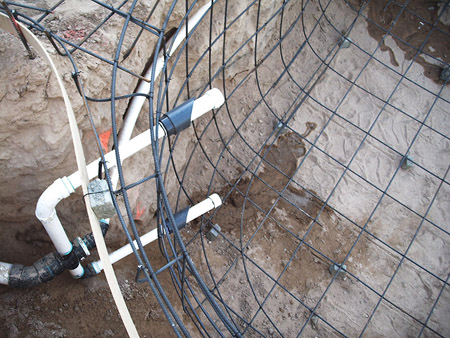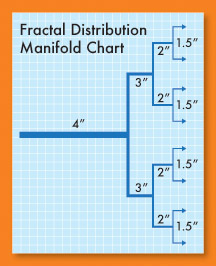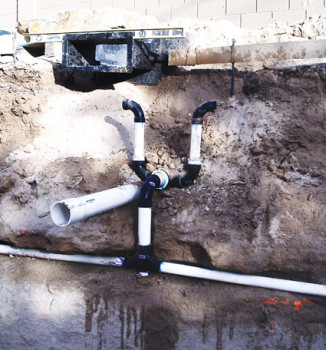
Filtration, circulation, depth and dissolved oxygen content are the major factors that set a pond with fish in it apart from other water features. While these are all important, they cannot function properly without the connectivity created by the plumbing system. Proper plumbing is one of the most overlooked areas of pond design. Proper plumbing isn’t simply connecting the pieces; it involves proper pipe sizing, the efficient placement of components and determining how you will get the volume of water required out of and back into the pond. When upgrading poorly or underbuilt ponds, the existing plumbing is usually the most difficult obstacle to overcome.
Once a pond design has been agreed upon aesthetically, the volume can be calculated. With the volume determined, you can add 10 percent for filtration and use that number for the total volume and flow to get the desired turnover rate. Turnover rate is the volume of water pumped through filtration per hour. Filtration should be between 5 percent and 10 percent of pond volume. Better filtration with higher dissolved oxygen content allows you to build toward the 5 percent marker, while pressurized filtration, bog filtration and other types that are less efficient force the equation closer to the 10 percent range. This percentage includes all filtration, including prefiltration. Fish ponds need a turnover rate of at least once per hour, although slightly more is better. Smaller ponds require a higher turnover rate and larger ponds of 100,000 gallons or more can start the decline toward less than once per hour depending on circulation and dissolved oxygen content. All of this requires a large amount of plumbing and careful thought.
Out and Back In
The first plumbing calculation to be determined is removing water from the pond. Out first, then back in. The outflow will be through skimmers, bottom drains and sometimes mid-water drains. Properly built under-gravel filtration with a grid system is considered a bottom drain. Outflow piping sizes from bottom drain circuits is almost always 3- or 4-inch, and skimmer returns can be in 2-inch when plumbed as direct suction to a pump. Return piping from garden ponds with a waterfall usually has the majority of the water returning through the falls. One or two return lines in 1-inch, 1.25-inch, 1.5-inch or 2-inch is usually enough to create the necessary circulation or current flow required to prevent dead zones in many ponds.
Formal ponds and larger ponds with waterfalls, where up to half or more of the returning water is through pond returns or jets, is where the return plumbing gets complicated. These systems usually require multiple valves and manifolds with a large number of lines to regulate the flow evenly and circulate the water properly…but there is another way.Fractal Distribution
Fractal distribution manifolds have been around for some time in other industries, and the concept of fractal distribution has been gaining popularity in the pond industry for some time.
Fractal distribution is about self-regulating the flow through manifolds with pipe sizing and length calculated to create a system where the water more evenly divides itself between the individual outlets without a valve on each line. This can save time and money by eliminating a number of valves that will usually never get used after the pond is set up anyway.
Doing the Math
 The concept is simple once you understand the sizing system. A 4-inch pipe has a cross-sectional diameter of approximately 12.5 square inches, a 3-inch pipe is approximately 7 square inches, a 2-inch pipe is just over 3 square inches and a 1.5-inch pipe is approximately 1.75 square inches. Each pipe size is approximately half of the pipe size above it, allowing you to divide any of the initial larger pipes into an approximate multiple equivalent of the smaller pipes.
The concept is simple once you understand the sizing system. A 4-inch pipe has a cross-sectional diameter of approximately 12.5 square inches, a 3-inch pipe is approximately 7 square inches, a 2-inch pipe is just over 3 square inches and a 1.5-inch pipe is approximately 1.75 square inches. Each pipe size is approximately half of the pipe size above it, allowing you to divide any of the initial larger pipes into an approximate multiple equivalent of the smaller pipes.
If two pond returns are needed originating from one 2-inch pipe, each return should not be 2-inch with two valves. The 2-inch can have one valve for isolation when servicing and then be split into two 1.5-inch returns. Pipe length will always have an effect on flow rates and is one of the concepts of fractal distribution that cannot be mimicked accurately in most pond designs. This is easily overcome by using a simple restrictor in any return that flows more than the others on a given circuit. Restrictors are easy to make and can be press-in bushings or thread-in bushings when the return used has threads. A restrictor in one return line at the outlet makes up for the increased pipe friction in others. The restrictor forces more flow to the other outlets without reducing the total flow.
A 3-inch return manifold can have two 2-inch returns or four 1.5-inch returns. A 4-inch manifold can have two 3-inch pipes going in opposite directions reduced to a total of four 2-inch or eight 1.5-inch returns into the pond. This works extremely well as a gravity-flow return manifold from the top of a biofilter. This can also be used when simplifying a return circuit by creating a loop manifold that surrounds a pond. A 3- or 4-inch loop manifold can have individual small returns right off the larger pipe as long as the total area of the outlet diameters doesn’t exceed the area of the diameter of the main loop.

The concept of fractal plumbing can also have an advantage when remote filtration is used. Instead of having a large number of 1.5-inch or 2-inch lines in a trench for a long distance from a filter or pump to the pond, one or two 3- or 4-inch lines can be buried and split up at the pond’s edge, simplifying the layout. This also reduces overall pipe friction, making the system more efficient.
On the bottom drain circuits, separate piping is always best and you should never plumb two 4-inch drains together into one 4-inch exit pipe. The flow will always favor the drain with the least resistance and there is no way to effectively balance them. You can consider two 3-inch drains into one 4-inch exit pipe as a way to simplify multiple drains into one pre-filter inlet or two 2-inch skimmer outlets into one 3-inch line traveling to the pump.
While combined drains cannot be balanced easily, skimmers can. Skimmers on a combined manifold flowing unevenly can be regulated with a slight restrictor in the skimmer that flows the most.
Start thinking about your plumbing as “fractal” and you can save money and time when plumbing your next project.



Awesome!!! Thanks for the instrutions!!!